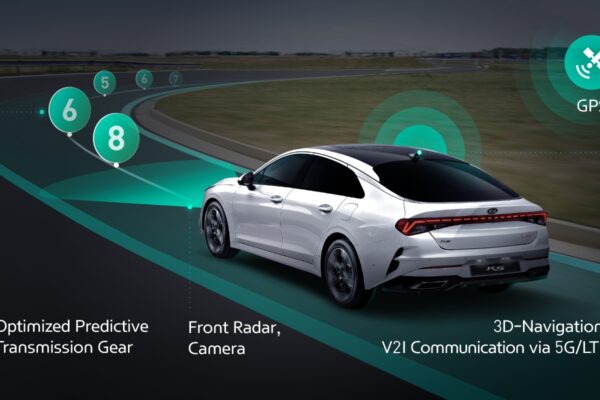
Hyundai, Kia connect transmission to environmental sensors
The new system uses software in the Transmission Control Unit (TCU) that collects and interprets real-time data from various sources. This includes 3D navigation with a precise road map as well as cameras and radar for adaptive cruise control. The 3D navigation data includes information on altitude, gradient, curve progression and various special features on the road as well as the current traffic situation. The radar determines the distance to vehicles in front and their speed, and a front camera provides information on the lane.
Taking all this data into account, the transmission control unit uses Artificial Intelligence to calculate the optimum strategy for real-time driving situations and selects the gears accordingly. For example, if a relatively long delay is expected and the radar does not detect any irregular speed with the vehicle in front, the transmission clutch temporarily switches to neutral mode to save fuel. If a bend is in sight, the transmission will downshift in anticipation.
When testing a vehicle with ICT-connected shift system on a very winding road, the number of gearshifts in bends was 43 % lower than in a vehicle without the system. Accordingly, the number of brake applications was also reduced by 11 %, which also counteracted driver fatigue and brake wear.
When rapid acceleration was required when entering the motorway, the system automatically switched to Sport mode to facilitate integration into the traffic flow. Once this process was complete, the vehicle automatically returned to its original driving mode, allowing safe and efficient driving.
In addition, the system automatically applied the engine brake when the accelerator was released if road thresholds, gradients or a change in speed limit was detected. And if the radar detected a change in the distance to the vehicle in front, the system automatically selected the optimum gear, which improved the quality of the ride.
The intelligent gearshift system is also in harmony with autonomous technology. In the era of autonomous vehicles, the system contributes to both higher fuel efficiency and a stable driving experience by providing the ability to respond in real time to road and traffic conditions.
The two Korean automakers plan to use the technology in future models. In addition, they plan to further develop the ICT-linked shift system into an even more intelligent transmission technology that communicates with traffic signaling systems based on the LTE or 5G mobile phone standards and can detect the intentions of drivers – resulting in further refined shift control.
Related articles:
Online platform automates software integration for networked vehicle architectures
Consortium tests satellite-based merging in traffic
Aptiv, Hyundai join forces for autonomous driving
 If you enjoyed this article, you will like the following ones: don't miss them by subscribing to :
eeNews on Google News
If you enjoyed this article, you will like the following ones: don't miss them by subscribing to :
eeNews on Google News




